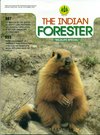Population Estimation of Resident Vultures in Gujarat
DOI:
https://doi.org/10.36808/if/2018/v144i10/139571Keywords:
Egyptian Vulture, Gujarat State, Gyps Vultures, Long-Billed Vulture, Population Estimation, Red-Headed Vulture, White-rumped VultureAbstract
Statewide vulture population estimates in Gujarat have been conducted for the years 2005, 2007, 2010, 2012 and 2016 by Gujarat State Forest Department and GEER Foundation with the support of various NGOs, nature clubs, ornithologists and birdwatchers of the state. The entire state was surveyed simultaneously with uniform methodology during two days of May 2016. A total of 999 individuals of 4 species of vultures were estimated. Of the total 999 vultures, 843 (84.38%) individuals were Gyps vultures (including 458 White-rumped Vultures and 385 Long-billed Vultures). Over a period of a decade (2005-2016), population of Gyps vultures declined by 68.15% from 2,647 individuals to 843 individuals. The decadal (2005-2016) population change for Gyps vultures has indicated 78.55% decline for the White-rumped Vulture and 2.39%. increase for the Long-billed Vulture. Populations of Red-headed Vulture and Egyptian Vulture were estimated in 2012 and 2016 which revealed 300% population rise (i.e. 8 to 24 individuals) for the Red-headed Vulture and 36% population rise (i.e. 97 to 132 individuals) for the Egyptian Vulture.References
IUCN (2018). The IUCN Red List of Threatened Species. Version 2017-3. . Downloaded on 10 June 2018
Kamboj R.D., Tatu K. and Munjpara S.B. (2016). Status of Vultures in Gujarat – 2016. Gujarat Ecological Education and Research (GEER) Foundation, Gandhinagar 94 pp.
Oaks J.L., Gilbert M., Virani M.Z., Watson R.T., Meteyer C.U., Rideout B.A., Shivaprasad H.L., Ahmed S., Chaudhry M.J.I., Arshad M., Mahmood S., Ali A. and Khan A.A. (2004). Diclofenac residues as the cause of vulture population declines in Pakistan. Nature, 427: 630–633.
Pandey C.N. and Jethva B. (2005). Status of Vultures in Gujarat2005. Gujarat Ecological Education and Research (GEER) Foundation 41 pp.
Pandey C.N., Jethva B.J. and Vyas V.R. (2009). Status survey of Gyps vultures in Gujarat–2007 (A state-wide survey of Gyps vulture nesting and population). Gujarat Ecological Education and Research (GEER) Foundation, Gandhinagar 80 pp.
Prakash V. (1999). Status of vultures in Keoladeo National Park, Bharatpur, Rajasthan, with special reference to population crash in Gyps species, J. Bombay Natural History Society, 96: 365-378.
Prakash V., Pain D.J., Cunningham A.A., Donald P.F. and Prakash N. (2003). Catastrophic collapse of Indian White-backed Gyps bengalensis and Long-billed Gyps indicus vulture populations, Biol. Conservation, 109:381-390.
Rodgers W.A. and Panwar H.S. (1988). Wildlife Protected Area Network in India: Published by Wildlife Institute of India, Dehradun.
Tatu K., Vyas V., Munjpara S., Pathak B. and Pandey C.N. (2012). Population Status of Critically Endangered Gyps Vultures in Gujarat, India, J. Bombay Natural History Society, 109 (1 and 2): 37-42.
Virani M., Gilbert M., Watson R., Oaks L., Benson P., Khan A.A., Sagar Baral H. and Giri J. B. (2001). Asian vulture crisis project: Field results from Pakistan and Nepal for the 2000-2001 field seasons. In: Reports from the Workshop on Indian Gyps vultures. 4th Eurasian Congress on Raptors (Eds.: Katzner, T. & J. ParryJones), The National Birds of Prey Centre, Newent, Gloucestershire, UK, 6-8 pp.
Downloads
Downloads
Published
How to Cite
Issue
Section
License
Unless otherwise stated, copyright or similar rights in all materials presented on the site, including graphical images, are owned by Indian Forester.





